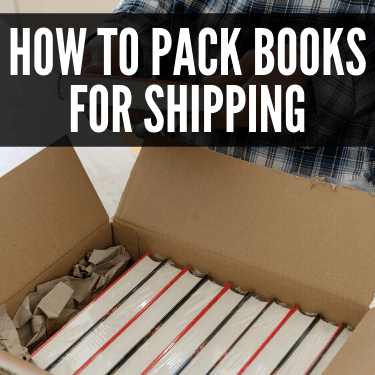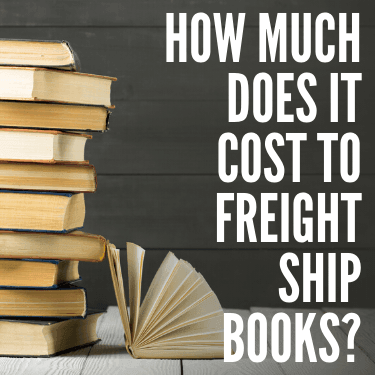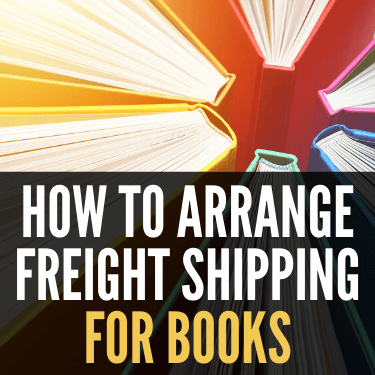Freight shipping books is the best method for getting books to bookstores and warehouses, no matter where they are. If you’re shipping a bulk order of books, then you need a trustworthy logistics partner like R+L Global Logistics to ensure your shipment gets delivered on-time and in good condition. We understand the delicate nature of books and know how to transport them carefully to prevent damages.
Freight shipping books requires special attention to packaging. Books are highly susceptible to moisture and impact damage, so you need to make sure that you take measures to protect them during the trip, such as with shrink wrap, tape, and bubble wrap.

Freight shipping books might seem like an easy task, but a lot can go wrong if you aren’t careful about how you handle them. In addition to that, not all books are the same. Some have thinner, more fragile paper, while others have waxy paper. There are textbooks, pocketbooks, and every size in between. Most books printed nowadays have fabric or paper covers, but some have leather covers. Transporting leather in a freight truck is another challenge all in itself.
Although different kinds of books may have different requirements, there are two main concerns that you should have when you’re preparing to freight ship books around the U.S.
This process isn’t made any easier by the fact that books can be quite heavy. If you’re piling several stacks of books together, the weight can quickly get out of hand. That’s why large book shipments are often palletized: so that they can be moved by forklift instead of human hands.
In order to prepare books for packaging, you need to ensure that you are taking every possible measure to protect them from damages. Every layer of protection helps ensure your books stay dry and intact throughout the trip.
To begin, you’re going to need to wrap each individual book in plastic. It’s the standard to use shrinkwrap, but if that’s not an option then regular plastic wrap will work fine. Not only does this help keep the books dry, but it holds them closed to reduce physical damages to the individual pages. If the book cannot accidentally fall open, then it will be much more resistant to crumpling, folding, and tearing. This is especially important for paperback books.
After you have wrapped the individual books in plastic, you can wrap them in another layer of protection in the form of kraft paper or wrapping paper. This step is usually not imperative, but if the books you are shipping are old, delicate, or unusually valuable, then you should consider taking the extra time to wrap them again.
The next step in the process depends on how you want to palletize your shipment. If you want to stack the books straight on a pallet, then you can skip this part. However, that method leaves the books susceptible to damages, so it’s recommended that you read on for information about the best way to keep your books safe in shipping.

Once your books have been plastic-wrapped, then you need to pack them in cardboard boxes. However, it is extremely important that you are careful when selecting the size box you intend to use. You need to make sure that the box you select will be the perfect dimensions to fit a stack of books with minimal space around the edges.
Any extra space between the edges of the books and the sides of the box should be filled with packing materials like packing peanuts, paper, or bubble wrap to prevent the books from shifting around. If the books move around inside their boxes, they could hit the inside of the box and get damaged. They would also be more susceptible to damages from being dropped or knocked accidentally.
Before you close up the box, you should fill in any remaining space with packing material as well, to ensure the books won’t hit the top of the box if the truck hits a bump in the road. Then, when you tape up the box, ensure that you tape over all the seams. This helps to protect the contents from moisture, and can prevent the box from accidentally opening before it reaches its destination.
Once you have all your books in moderately sized boxes, you will need to palletize them to make them easier to move. Books are heavy, so palletizing them allows for them to be moved with a forklift so they can be loaded and unloaded with more ease. Regardless of whether you are palletizing boxes or unboxed books, the process is similar.
Palletizing isn’t just stacking whatever you want on a pallet at random and patting yourself on the back. Many things can go wrong if you don’t follow the palletizing best practices perfected by others in the shipping business. If you want to know how to palletize boxes, read on.
The first step in palletization is finding a proper pallet. You should double-check every single pallet for moisture, decay, and structural damage. Look for dark spots, splinters, and any part that may look weakened. If you select a bad pallet, you could put truckers and forklift operators at risk, and you could be held liable if anyone is injured from your faulty pallet breaking.
Next, once you have inspected a pallet, you need to lay down a sheet of durable plastic or fiberboard to cover up the holes in the pallet and create a flat surface to stack on. Then, you’ll want to stack the boxes in columns, with the corners of each box in line with the corners of the boxes above and below it. This gives the pallet more strength and stability since the strongest part of a box is its corners. For even more stability, you can add additional plastic or fiberboard sheets between every second or third layer to help hold everything together.
Once you have stacked your pallet as high as you want it (not exceeding 6 feet in height), then it’s time to secure it. You do this by stretch wrapping the entire pallet with plastic wrap several times. You can also loop this stretch wrap through the forklift holes in the pallet to hold the boxes to it more easily—as long as you don’t cover up the holes or make it more difficult to move the pallet with a forklift. You can also secure the boxes to the pallet with durable nylon straps.
If you are palletizing unboxed books, you will need to be more careful about how you handle the process. For the most part, the process is similar to palletizing boxes, but with a few key differences. First of all, instead of stacking in columns, you should stagger the books so they overlap. Also, the additional plastic or fiberboard sheets between layers were optional with the boxes, but they are much more necessary in this case. Books are not perfectly flat, and you need to add in these sheets to ensure you keep a level surface to stack on.
When palletizing unboxed books, you should also consider reinforcing the corners with cardboard. The edges of the books are a lot more fragile than the corners of boxes, so you should try to protect them as best you can. Once you’ve done that, you can simply stretch wrap and strap down the books just like with the boxes.
Need to ship books with a special touch? Learn more with our White Glove Delivery Guide.

As with all freight shipping, it’s impossible to know exactly how much you’re going to pay. There are countless factors that influence the price of shipping something, including:
Because of that, there’s no way to know what you would have to pay beforehand. Plus, if you were quoted a specific rate last year, the rate you get quoted this year would be different. Same for if you had just shipped something a month or two ago. The rates fluctuate all the time, but that’s just how the shipping industry works.
In terms of shipping books, the most reasonable choice for the method of shipping would be full truckload (FTL), and there are many good reasons why.
First of all, if you’re shipping books domestically, then truckload shipping is the way to go. Since you wouldn’t consider shipping a delicate commodity like books on a freight train, the only other competitor is a cargo plane. You could ship your books by air, but you would end up paying a much higher rate just to get your books delivered quickly. Unless you need them immediately, it’s best to save some money and stick to the ground. Besides, you can still get expedited shipping for trucks so you can still get your freight delivered in a matter of hours.
Once you know that you’re going to be shipping on a freight truck, you still have another decision to make. There are two main ways to ship your freight: LTL and FTL.
LTL (Less-than-Truckload) shipping is usually a more affordable option, but it’s not without its drawbacks. LTL shipping is commonly used for shippers who only have a few pallets, since the trucks are loaded with several different shipments that are heading in the same direction at the same time, to save money. This puts your goods at a greater risk of damage and theft, since not every shipper is careful about securing their goods. If a pallet topples, it could take your books with it. Additionally, since the truck is carrying more than one shipment at a time, that means it spends more time stopped and being loaded or unloaded, providing more opportunities for thieves.
Shipping as FTL means your books would have an entire truck to themselves. They can go directly to their destination quickly and with no additional stops, and you wouldn’t have to worry about them getting damaged by other shipments. It might be a bit more expensive than LTL, but it’s often better to pay more for the security and peace of mind associated with knowing your shipment will arrive at its destination intact.

The easiest way to arrange shipping for your books is with the help of a Third-Party Logistics company (3PL) like R+L Global Logistics. 3PLs act as a liaison between shippers and carriers as a way of ensuring high-quality working relationships between the two parties. For shippers, a 3PL can help them find the best deal for moving their freight, and get them in touch with a vetted and reliable carrier with a good reputation. For carriers, a 3PL ensures that they get paid for their work, and can give them a steady stream of high-quality loads to move. Both parties benefit from the services of a 3PL.
But what exactly does the process of shipping with a 3PL look like? Thankfully, it’s pretty straightforward.
The first thing you would need to do as a shipper is to gather up all the information on the load you need to have shipped, including the zip codes for the origin and destination. Then, once you have that information on-hand, you would call the logistics company to get a quote for how much they think it will cost to move your shipment. If you decide to move forward with that price point, that representative will begin reaching out to different carriers to find the best value for you, so you don’t have to waste time comparing prices yourself.
All the hard parts involved with shipping freight, like communicating with the carrier and negotiating prices, will be left up to the 3PL to do for you. All you have to do is establish a time and a place for the shipment to be picked up, and the rest will follow like clockwork.
Compared to the process of finding a trustworthy carrier and setting everything up yourself, working with a 3PL is a breeze. Plus, when you work with a 3PL, you’ll have access to a range of other services and benefits that the company also offers, such as white glove service and warehousing. That, on top of quick service, high-end track and trace technology, and flexibility, makes it more than worthwhile to consider working with a well established 3PL like R+L Global Logistics.
Freight shipping books doesn’t have to be difficult. With R+L Global Logistics on your side, you can ship anything with ease! Our team of dedicated experts can boast 24/7 availability, multilingual specialists, and unparalleled flexibility to meet any customer’s needs! Not only that, but we can offer a range of different benefits such as:
With our unbeatable customer service and dedication to uphold our 99.5% on-time delivery record, you know you can get the best-in-class service from R+L Global Logistics. Whether you need a truck for freight shipping books, or any other commodity, we can provide you with the service you need. We can get your shipments delivered on-time, every time. What are you waiting for? Call (866) 353-7178 to get your free freight quote today!
R+L Global Logistics
315 NE 14th St., Ocala, FL 34470